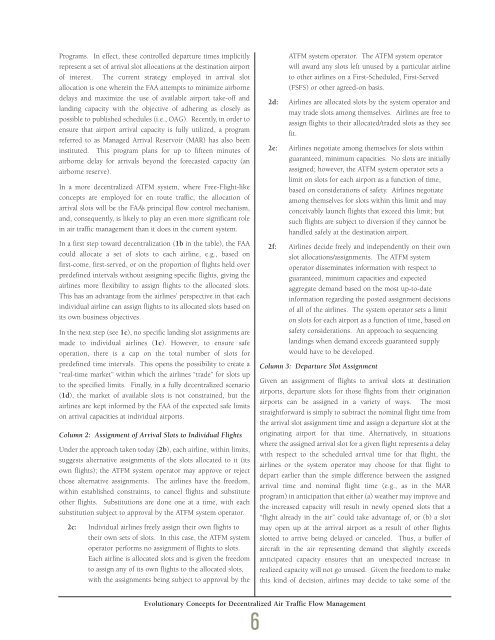1998 - Draper Laboratory
1998 - Draper Laboratory
1998 - Draper Laboratory
- No tags were found...
Create successful ePaper yourself
Turn your PDF publications into a flip-book with our unique Google optimized e-Paper software.
Programs. In effect, these controlled departure times implicitlyrepresent a set of arrival slot allocations at the destination airportof interest. The current strategy employed in arrival slotallocation is one wherein the FAA attempts to minimize airbornedelays and maximize the use of available airport take-off andlanding capacity with the objective of adhering as closely aspossible to published schedules (i.e., OAG). Recently, in order toensure that airport arrival capacity is fully utilized, a programreferred to as Managed Arrival Reservoir (MAR) has also beeninstituted. This program plans for up to fifteen minutes ofairborne delay for arrivals beyond the forecasted capacity (anairborne reserve).In a more decentralized ATFM system, where Free-Flight-likeconcepts are employed for en route traffic, the allocation ofarrival slots will be the FAA’s principal flow control mechanism,and, consequently, is likely to play an even more significant rolein air traffic management than it does in the current system.In a first step toward decentralization (1b in the table), the FAAcould allocate a set of slots to each airline, e.g., based onfirst-come, first-served, or on the proportion of flights held overpredefined intervals without assigning specific flights, giving theairlines more flexibility to assign flights to the allocated slots.This has an advantage from the airlines’ perspective in that eachindividual airline can assign flights to its allocated slots based onits own business objectives.In the next step (see 1c), no specific landing slot assignments aremade to individual airlines (1c). However, to ensure safeoperation, there is a cap on the total number of slots forpredefined time intervals. This opens the possibility to create a“real-time market” within which the airlines “trade” for slots upto the specified limits. Finally, in a fully decentralized scenario(1d), the market of available slots is not constrained, but theairlines are kept informed by the FAA of the expected safe limitson arrival capacities at individual airports.Column 2: Assignment of Arrival Slots to Individual FlightsUnder the approach taken today (2b), each airline, within limits,suggests alternative assignments of the slots allocated to it (itsown flights); the ATFM system operator may approve or rejectthose alternative assignments. The airlines have the freedom,within established constraints, to cancel flights and substituteother flights. Substitutions are done one at a time, with eachsubstitution subject to approval by the ATFM system operator.2c: Individual airlines freely assign their own flights totheir own sets of slots. In this case, the ATFM systemoperator performs no assignment of flights to slots.Each airline is allocated slots and is given the freedomto assign any of its own flights to the allocated slots,with the assignments being subject to approval by theATFM system operator. The ATFM system operatorwill award any slots left unused by a particular airlineto other airlines on a First-Scheduled, First-Served(FSFS) or other agreed-on basis.2d: Airlines are allocated slots by the system operator andmay trade slots among themselves. Airlines are free toassign flights to their allocated/traded slots as they seefit.2e: Airlines negotiate among themselves for slots withinguaranteed, minimum capacities. No slots are initiallyassigned; however, the ATFM system operator sets alimit on slots for each airport as a function of time,based on considerations of safety. Airlines negotiateamong themselves for slots within this limit and mayconceivably launch flights that exceed this limit; butsuch flights are subject to diversion if they cannot behandled safely at the destination airport.2f: Airlines decide freely and independently on their ownslot allocations/assignments. The ATFM systemoperator disseminates information with respect toguaranteed, minimum capacities and expectedaggregate demand based on the most up-to-dateinformation regarding the posted assignment decisionsof all of the airlines. The system operator sets a limiton slots for each airport as a function of time, based onsafety considerations. An approach to sequencinglandings when demand exceeds guaranteed supplywould have to be developed.Column 3: Departure Slot AssignmentGiven an assignment of flights to arrival slots at destinationairports, departure slots for those flights from their originationairports can be assigned in a variety of ways. The moststraightforward is simply to subtract the nominal flight time fromthe arrival slot assignment time and assign a departure slot at theoriginating airport for that time. Alternatively, in situationswhere the assigned arrival slot for a given flight represents a delaywith respect to the scheduled arrival time for that flight, theairlines or the system operator may choose for that flight todepart earlier than the simple difference between the assignedarrival time and nominal flight time (e.g., as in the MARprogram) in anticipation that either (a) weather may improve andthe increased capacity will result in newly opened slots that a“flight already in the air” could take advantage of, or (b) a slotmay open up at the arrival airport as a result of other flightsslotted to arrive being delayed or canceled. Thus, a buffer ofaircraft in the air representing demand that slightly exceedsanticipated capacity ensures that an unexpected increase inrealized capacity will not go unused. Given the freedom to makethis kind of decision, airlines may decide to take some of theEvolutionary Concepts for Decentralized Air Traffic Flow Management6
















